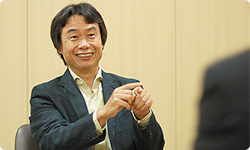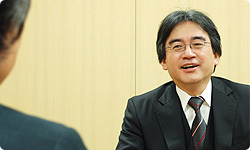2. The Reason Mario Wears Overalls
Mario’s trademarks are his moustache, his hat and his overalls. Why did you decide to give him this look? I have no doubt you’ve spoken about this many times before, but I’d like to take this opportunity to ask you to tell us about it one more time.
Certainly. The original Mario was a 16 X 16 pixellated image. At that time, when games made overseas used human characters, they were always rendered with life-like proportions.
It felt as if the developers weren’t happy unless they’d drawn a figure that was eight-heads tall.
Or sometimes it would be six-heads tall. But actually, the number of pixels we were able to use was so limited that, if we did that, we’d only have had a couple of pixels for the face.
With two pixels, you wouldn't even have been able to draw eyes. You'd basically have ended up with a matchstick figure. In early video games from overseas, that kind of figure often featured.
And as they just didn’t resemble human figures, I was absolutely convinced that they’d been designed by people who couldn’t draw!
(laughs)
I thought it was most likely that it was the programmer who was drawing these figures. But I thought: “I know how to draw!" I mean, I'm not saying I can draw as well as an artist, but I was confident that I was better at drawing than a programmer. That’s why I started by saying: "Right, let's draw something that actually looks like a person's face!" So I drew the eyes, the nose, the mouth and...
There’s absolutely no way that you would have had enough pixels, right?
Right, there weren’t enough. Before you know it, you’ve used up 8 X 8 pixels. But if you draw a nose then a moustache, you don't really know if it's a mouth or a moustache, and it saves pixels.
So if you draw a moustache, you don’t have to draw a mouth.
You don’t have to draw a mouth, which makes a big difference. You only need one pixel for the chin and if you draw two vertical pixels, you've got eyes that hopefully look quite cute. (laughs) Also, because you can’t fully draw hair, by making him wear a hat, you can reduce the hair to only a couple of pixels.
So you made Mario wear a hat in order to keep the number of pixels you were using down?
Well, if you have hair, it also presents problems to animate it. And if you draw a hat, you can have the eyes directly beneath it.
And with that the face is complete.
But when you come to draw the body using the remaining pixels, there's a limit to what you can do. Furthermore, because we wanted him to run properly, we needed to animate him and we were only able to use three different frames for this. When Mario is running he moves his arms, but in order to make that movement easier to see, I thought it would be best to make his arms and his body different colours. So I wondered whether there was a type of outfit which was like that…
And that’s how you came up with overalls! (laughs)
Right! Overalls were the only option! So that’s how we ended up giving Mario overalls. Fortunately, the game was set on a construction site so we thought we had no other option but to make him a carpenter! (laughs)

There’s a sense of inevitability about all of this! (laughs)
Then we gave Mario a pair of white gloves, in order to make his movements easier to spot when he jumped.
So the entire design was a case of form being dictated by function. You can really see that your specialist field, industrial design, is evident in the final result. Then, because he jumped up and down, he became known as “Jumpman”, right?
Well, I called him “Mr. Video”. My plan was to use the same character in every video game I made.
So you had that plan right from the start? Why did you intend to use him in every video game you made?
Well, I thought the way Hitchcock7 cropped up in all the films he directed was really cool! (laughs) 7 Alfred Hitchcock (1899-1980) was a British film director known as the master of suspense. He directed many films including Rebecca (1940), Dial M For Murder (1954), Psycho (1960) and The Birds (1963).
(laughs)
Or take manga artists like Osamu Tezuka8 and Fujio Akatsuka9 who have the same characters popping up in a variety of different works. I think I was probably influenced by that at the time. 8 Osamu Tezuka (1928-1989) is seen as the founder of Japanese manga as well as being a major contributor to its development. His most well-known works include Astro Boy, Kimba the White Lion and Black Jack. 9 Fujio Akatsuka (1935-2008) was a leading manga artist whose major works include humorous comics such as Osomatsu-kun, Tensai Bakabon and Moretsu Ataro.
If you were considering using the character in a number of titles, you must have been satisfied with the way Mario had turned out.
I felt that I had come up with a pretty solid character, which is why I thought: “Right, I’ll keep using him from now on!” That’s why I decided a solid, imposing name like “Mr. Video” would work best. But thinking back, I don’t think I should have gone with that name. Someone at Nintendo of America actually came up with the name Mario. If he had been called “Mr. Video,” he might have disappeared off the face of the earth a long time ago. (laughs)
(laughs) So moving on now to the game Mario appeared in after Donkey Kong…
That was Mario Bros. 10 10 Mario Bros. was a platform game released both in the arcades and on the Famicom in Japan in 1983.
Mario Bros. was a pretty impressive game and with the turtle shells that could be removed11, as well as its very distinctive game world, it had elements that would connect it to Super Mario Bros. 11 The turtle shells could only be removed from their owners in the arcade version of Mario Bros., not in the Famicom or Game Boy Advance versions.
That’s right. Mario Bros. was also a collaborative effort with Yokoi-san. He proposed that we make a competitive game and development started from there. In Donkey Kong, if Mario fell any distance that was greater than his height, he would be stunned and you’d lose a turn. But this time round, Yokoi-san said: “Why don’t we let him jump down from higher places?” I thought that if we did that, it wouldn’t be much of a game. But as I pondered it, I thought: “Why shouldn’t Mario be able to perform some super-human feats?” Then we made a prototype with Mario running and bouncing around and we realised that this was great fun.
So Mario became able to jump to higher places than he could in Donkey Kong.

That’s right. But at this point, we hit something of a dead end as we wondered what kind of game it was going to be. It was at this point that Yokoi-san, who is someone who considers problems from first principles, said: “Since we’ve got all these floors, why don’t we make it so that Mario can hit the floors from beneath, and defeat the enemy?“ But when we actually tried it we found that it was incredibly easy. Before you knew it, you had no enemies left.
So without any risk to yourself, you could defeat your enemies simply by hitting them from below.
And that made it a really cowardly kind of game. So then we made it so that you hit the enemies from below before going up to deliver the decisive blow.
So you had to go up to strike the finishing blow.
That’s when we thought about what kind of creature could withstand being struck from below and would eventually recover. We racked our brains thinking what we could use...
And that’s how you came up with the turtle! (laughs)
The turtle was the only solution! (laughs) Strike it from below and it flips over! Leave it for a while and it rights itself!
